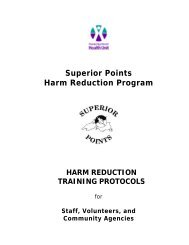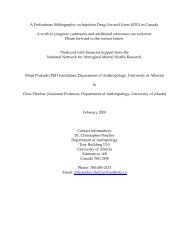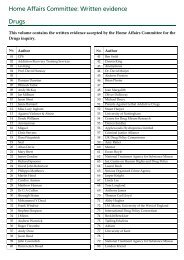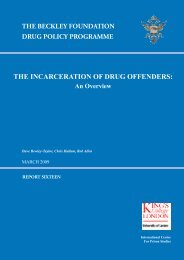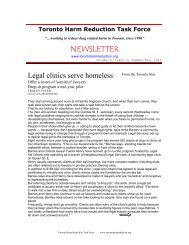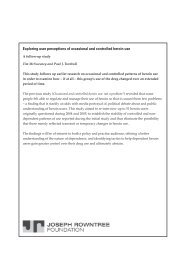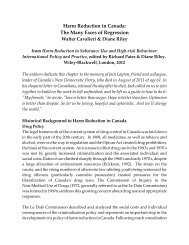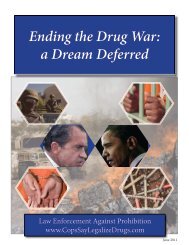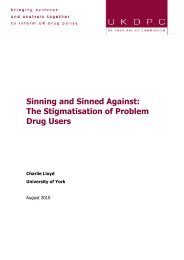and the building of the harm reduction-abstinence ... - ResearchGate
and the building of the harm reduction-abstinence ... - ResearchGate
and the building of the harm reduction-abstinence ... - ResearchGate
Create successful ePaper yourself
Turn your PDF publications into a flip-book with our unique Google optimized e-Paper software.
246<br />
S.H. Kellogg / Journal <strong>of</strong> Substance Abuse Treatment 25 (2003) 241–247<br />
able to improve on its record <strong>of</strong> success. Second, by creating a<br />
continuum <strong>of</strong> care, a <strong>the</strong>rapeutic ‘‘safety net’’ can be created<br />
(see also Marlatt, 1998b). The goal would be that <strong>the</strong> life <strong>and</strong><br />
health <strong>of</strong> relapsing patients would be preserved through <strong>the</strong><br />
work <strong>of</strong> <strong>the</strong> <strong>harm</strong>-<strong>reduction</strong> organizations, <strong>and</strong>, using <strong>the</strong><br />
momentum <strong>of</strong> a gradualist approach, <strong>the</strong>y would be able to<br />
return more rapidly to a drug- <strong>and</strong> alcohol-free life.<br />
6. Conclusion<br />
We are currently living in a time <strong>of</strong> rich <strong>the</strong>rapeutic<br />
possibilities for working substance-using <strong>and</strong> substancedependent<br />
patients. This creativity is taking place both<br />
within <strong>the</strong> <strong>harm</strong>-<strong>reduction</strong> <strong>and</strong> <strong>abstinence</strong>-oriented spheres.<br />
To optimize care for those who are addicted, it would be<br />
ideal to connect <strong>harm</strong> <strong>reduction</strong> <strong>and</strong> <strong>abstinence</strong> treatment<br />
into a continuum that has <strong>the</strong> cessation <strong>of</strong> drug <strong>and</strong> alcohol<br />
use <strong>and</strong> <strong>the</strong> healing <strong>of</strong> mind <strong>and</strong> body as <strong>the</strong> desired end<br />
point. Gradualism has been put forward as an organizing<br />
principle to facilitate this development.<br />
Acknowledgments<br />
This paper is adapted from a presentation that was given<br />
on April 6th, 2001, at a conference entitled, ‘‘The Great<br />
Debate: Abstinence vs. Harm Reduction in Addiction<br />
Treatment’’ that was held at The New School University.<br />
This conference was conceptualized <strong>and</strong> sponsored by <strong>the</strong><br />
New York State Psychological Association Division on<br />
Addictions Executive Committee, whose members include:<br />
Julie Barnes, F. Michler Bishop, Lisa Director, Scott<br />
Kellogg, Robert Lichtman, A. Jonathan Porteus, Marlene<br />
Reil, Debra Rothschild, Suzanne Spross, Andrew Tatarsky,<br />
<strong>and</strong> Alex<strong>and</strong>ra Woods. It was co-sponsored by <strong>the</strong> Masters<br />
Program in Mental Health <strong>and</strong> Substance Abuse Counseling<br />
at The New School University. Support for this work was<br />
received from <strong>the</strong> Division on Addictions <strong>of</strong> <strong>the</strong> New York<br />
State Psychological Association <strong>and</strong> from NIH-NIDA Grant<br />
P60-DA05130. I would like to thank <strong>the</strong> NYSPA Division<br />
on Addictions Executive Committee, McWelling Todman<br />
(at The New School University), Mary Jeanne Kreek, <strong>and</strong><br />
Nadine Kellogg for <strong>the</strong>ir support <strong>and</strong> assistance.<br />
References<br />
Alper, K. R., Lots<strong>of</strong>, H. S., Frenken, G. M. N., Daniel, J., & Bastiaans, J.<br />
(1999). Treatment <strong>of</strong> acute opioid withdrawal with ibogaine. American<br />
Journal on Addictions, 8, 234–242.<br />
Ball, J. C., & Van de Wijngaart, G. F. (1994). A Dutch addict’s view <strong>of</strong><br />
methadone maintenance – an American <strong>and</strong> a Dutch appraisal. Addiction,<br />
89, 799–802.<br />
Biernacki, P. (1986). Pathways from heroin addiction: Recovery without<br />
treatment. Philadelphia: Temple University Press.<br />
Bly, J. (1992). Iron John: A book about men. New York: Vintage Books.<br />
DanceSafe. (2003). Philosophy <strong>and</strong> vision [On-line]. Available: www.<br />
dancesafe.org.<br />
D’Aunno, T., & Pollack, H. A. (2002). Changes in methadone treatment<br />
practices: Results from a national panel study. 1988–2000. Journal <strong>of</strong><br />
<strong>the</strong> American Medical Association, 288, 850–856.<br />
D’Aunno, T., & Vaughn, T. E. (1992). Variations in methadone treatment<br />
practices. Journal <strong>of</strong> <strong>the</strong> American Medical Association, 267, 253–258.<br />
De Leon, G., Staines, G. L., Perlis, T. E., Sacks, S., McKendrick, K.,<br />
Hilton, R., & Brady, R. (1995). Therapeutic community methods in<br />
methadone maintenance (Passages): An open clinical trial. Drug <strong>and</strong><br />
Alcohol Dependence, 37, 45–57.<br />
Denning, P. (2001). Strategies for implementation <strong>of</strong> <strong>harm</strong> <strong>reduction</strong> in<br />
treatment settings. Journal <strong>of</strong> Psychoactive Drugs, 33, 23–26.<br />
Denning, P., & Little, J. (2001). Harm <strong>reduction</strong> in mental health: The<br />
emerging work <strong>of</strong> <strong>harm</strong> <strong>reduction</strong> psycho<strong>the</strong>rapy. Harm Reduction<br />
Communication 11 [On-line]. Available: www.<strong>harm</strong><strong>reduction</strong>.org.<br />
Director, L. (2002). The value <strong>of</strong> relational psychoanalysis in <strong>the</strong> treatment <strong>of</strong><br />
chronic drug <strong>and</strong> alcohol use. Psychoanalytic Dialogues, 12, 551–579.<br />
Frankl, V. (1985). Logos, paradox, <strong>and</strong> <strong>the</strong> search for meaning. In<br />
M. J. Mahoney, & A. Freeman (Eds.), Cognition <strong>and</strong> psycho<strong>the</strong>rapy.<br />
New York: Plenum Press.<br />
Gelormino, A. (2002). Final report: Harm <strong>reduction</strong> hearing. Melbourne,<br />
Australia: World Federation <strong>of</strong> Therapeutic Communities Conference.<br />
Granfield, R., & Cloud, W. (1996). The elephant that no one sees:<br />
Natural recovery among middle-class addicts. Journal <strong>of</strong> Drug Issues,<br />
26, 45–61.<br />
Greenberg, J., & Mitchell, S. A. (1983). Object relations in psychoanalytic<br />
<strong>the</strong>ory. Cambridge, MA: Harvard University Press.<br />
Harm Reduction Coalition. (2003). Principles <strong>of</strong> <strong>harm</strong> <strong>reduction</strong> [On-line].<br />
Available: www.<strong>harm</strong><strong>reduction</strong>.org/prince.html.<br />
Higgins, S. T., Alessi, S. M., & Dantona, R. L. (2002). Voucher-based<br />
incentives: A substance abuse treatment innovation. Addictive Behaviors,<br />
27, 887–910.<br />
Ibrahim, Y. M. (1996, August 18). Rethinking ‘Harm Reduction’ for Glasgow<br />
addicts. New York Times [On-line]. Available: www.nytimes.com.<br />
Kellogg, S. (1993). Identity <strong>and</strong> recovery. Psycho<strong>the</strong>rapy, 30, 235–244.<br />
Khantzian, E. J. (1985). The self-medication hypo<strong>the</strong>sis <strong>of</strong> addictive disorders:<br />
Focus on heroin <strong>and</strong> cocaine dependence. American Journal <strong>of</strong><br />
Psychiatry, 142, 1259–1264.<br />
Klaw, E., & Humphreys, K. (2000). Life stories <strong>of</strong> Moderation Management<br />
mutual help group members. Contemporary Drug Problems, 27,<br />
779–803.<br />
Kohut, H. (1977). Preface. In J. D. Blaine, & D. A. Julius (Eds.), Psychodynamics<br />
<strong>of</strong> drug dependence: NIDA Research Monograph 12<br />
(pp. vii – ix). Rockville, MD: National Institute on Drug Abuse.<br />
Larimer, M. E., & Marlatt, G. A. (1990). Application <strong>of</strong> relapse prevention<br />
with moderation goals. Journal <strong>of</strong> Psychoactive Drugs, 22, 189–195.<br />
Majoor, B., & Rivera, J. (2003). SACHR: An example <strong>of</strong> an integrated,<br />
<strong>harm</strong> <strong>reduction</strong>-drug treatment program. Journal <strong>of</strong> Substance Abuse<br />
Treatment, 25, 255–260.<br />
Marlatt, G. A. (1996). Harm <strong>reduction</strong>: Come as you are. Addictive Behaviors,<br />
21, 779–788.<br />
Marlatt, G. A. (1998a). Highlights <strong>of</strong> <strong>harm</strong> <strong>reduction</strong>: A personal report<br />
from <strong>the</strong> first national <strong>harm</strong> <strong>reduction</strong> conference in <strong>the</strong> United States.<br />
In G. A. Marlatt (Ed.), Harm <strong>reduction</strong> ( pp. 3 –29). New York: Guilford<br />
Press.<br />
Marlatt, G. A. (1998b). Basic principles <strong>and</strong> strategies <strong>of</strong> <strong>harm</strong> <strong>reduction</strong>.<br />
In G. A. Marlatt (Ed.), Harm <strong>reduction</strong> (pp. 49–66). New York: Guilford<br />
Press.<br />
Marlatt, G. A., Blume, A. W., & Parks, G. A. (2001). Integrating <strong>harm</strong><br />
<strong>reduction</strong> <strong>the</strong>rapy <strong>and</strong> traditional substance abuse treatment. Journal <strong>of</strong><br />
Psychoactive Drugs, 33, 13–21.<br />
Marlatt, G. A., & Gordon, J. R. (Eds.) (1985). Relapse prevention: Maintenance<br />
strategies in <strong>the</strong> treatment <strong>of</strong> addictive behaviors. New York:<br />
Guilford Press.




